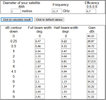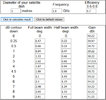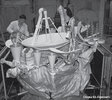It also has to do with the transmit frequency used, a 3 to 5 GHz amp uses a larger wave guide(s) out to the transmit antenna(s), this takes up valuable room on the satellite, a 11 to 12 GHz amp uses much smaller wave guide(s) for that frequency, it's all about the size and weight of stuff on the satellites.
Also take into consideration the free space attenuation for those frequency's, at 22,500 miles the free space attenuation on a "C" band signal with a TX power of 10 watts (+40 dBm) and a dish that is 10 feet in diameter would be about a -114 dB.
Now using the same 10 watt power figures for "kU" band (a 10 foot dish at Ku frequency's has a gain of 48 d

you get a -116.5 dB of signal loss.
So to compensate for the higher loss at the higher frequency's they use 200 watt power amps for "Ku" band, 200 watt power amps and wave guides to handle the power increase for "C" band would be a bit too heavy.
So using 200 watts for the TX side (+53 dBm) and a 1 meter dish with 38.5 dBi gain for "Ku" band you get a -113.5 dB loss, much better, and you can use a smaller dish.
You can get away with a lot at "Ku" band frequency's, bigger amps at the satellite, and smaller dishes on the ground.
For those that need to know, free space loss calculator....
https://www.pasternack.com/t-calculator-fspl.aspx



